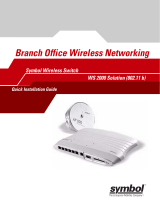
Motorola Solutions AP-7131N-FGR Access Point Installation Guide
8
For a more exhaustive overview of the antennas and associated components supported by the
Motorola Solutions access point family, refer to the Enterprise Wireless LAN Antenna Specification
Guide available at https://portal.motorolasolutions.com/Support/US-EN
2.4.2 Power Injector System
The AP-7131N-FGR can receive power via an Ethernet cable connected to the GE1/POE (LAN) port.
When users purchase a WLAN solution, they often need to place access points in obscure locations.
In the past, a dedicated power source was required for each access point in addition to the Ethernet
infrastructure. This often required an electrical contractor to install power drops at each access point
location. The Power Injector merges power and Ethernet into one cable, reducing the burden of
installation and allowing optimal access point placement in respect to the intended coverage area.
The Power Injector (Part No. AP-PSBIAS-1P3-AFR) is a high power POE Injector delivering up to 30
watts. The access point can only use a Power Injector when connecting the unit to the access point’s
GE1/POE port. The Power Injector is a separately ordered and not shipped with an AP SKU.
An AP-7131 and AP-7131N can also be used with the 3af power injector (AP-PSBIAS-1P2-AFR).
However, AP functionality is limited when powered by an AP-PSBIAS-1P2-AFR, since the AP has
Ethernet connectivity limited to only the GE1 port.
The Motorola Solutions access point Power Supply (Part No. 50-14000-247R) is not included with the
access point and is orderable separately as an accessory. If the access point is provided both POE
power over the GE1/POE connection, as well as the 50-14000-247R power supply concurrently, the
access point will source power from the 50-14000-247R supply only. Disconnecting AC power from
the 50-14000-247R, causes the AP to re-boot before sourcing power from the POE power injector. If
the AP is operating using injector supplied power, the AP will not automatically reboot if an AC
adapter is connected. The AP continues to operate with power supplied from the AC adapter without
change to the AP operating configuration. If using AC adapter supplied power and a change to the
AP’s operating configuration is warranted (for example, if needing to access the GE2 port), the AP
needs to be manually rebooted by the customer.
CAUTION
The access point supports any standards-based compliant power
source (including non-Motorola Solutions power sources). However,
using the wrong solution (including a POE system used on a legacy
Motorola Solutions access point) could either limit functionality or
severely damage the access point and void the product warranty.
!




















